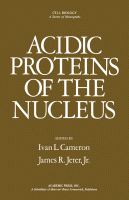Browse content
Table of contents
Actions for selected chapters
- Full text access
- Book chapterNo access
1 - DNA-Binding Proteins and Transcriptional Control in Prokaryotic and Eukaryotic Systems
VINCENT G. ALLFREY
Pages 1-27 - Book chapterNo access
2 - Isolation of the Nuclear Acidic Proteins, Their Fractionation, and Some General Characteristics
GORDHAN L. PATEL
Pages 29-57 - Book chapterNo access
3 - Extraction and Characterization of the Phenol-Soluble Acidic Nuclear Proteins
WALLACE M. LESTOURGEON and WAYNE WRAY
Pages 59-102 - Book chapterNo access
4 - Acidic Nuclear Phosphoproteins
LEWIS J. KLEINSMITH
Pages 103-135 - Book chapterNo access
5 - Characterization of Nuclear Phosphoproteins in Physarum polycephalum
BRUCE E. MAGUN
Pages 137-158 - Book chapterNo access
6 - The Nuclear Acidic Proteins in Cell Proliferation and Differentiation
WALLACE M. LESTOURGEON, ROGER TOTTEN and ARTHUR FORER
Pages 159-190 - Book chapterNo access
7 - Nonhistone Proteins of Dipteran Polytene Nuclei
H.D. BERENDES and P.J. HELMSING
Pages 191-212 - Book chapterNo access
8 - Acidic Nuclear Proteins and the Cell Cycle
JAMES R. JETER and IVAN L. CAMERON
Pages 213-245 - Book chapterNo access
9 - The Role of Nuclear Acidic Proteins in Binding Steroid Hormones
THOMAS C. SPELSBERG
Pages 247-296 - Book chapterNo access
10 - The Role of Acidic Proteins in Gene Regulation
R. STEWART GILMOUR
Pages 297-317 - Book chapterNo access
Author Index
Pages 319-333 - Book chapterNo access
Subject Index
Pages 334-343 - Book chapterNo access
Inside Back Cover
Pages 344-345
About the book
Description
Acidic Proteins of the Nucleus focuses on the functional role of acidic nuclear proteins in differential gene expression. Historically, these proteins are referred to as acidic in nature because they are insoluble in dilute mineral acids and their amino acid composition shows a preponderance of acidic over basic amino acid residues. After an introduction to DNA-binding proteins and transcriptional control in prokaryotic and eukaryotic systems, the subsequent chapters describe various approaches for isolating, separating, and characterizing acidic nuclear proteins. The core chapters specifically cover the isolation, fractionation, and characterization of acidic nuclear phosphoproteins, and the role of these proteins in cell proliferation, cell differentiation, and cell cycle. The last two chapters address the role of acidic nuclear protein in binding steroid hormones and in gene regulation. Each chapter contains some previously unpublished work and provides recommendations for future research. This book will be a good reference background for researchers of acidic nuclear proteins.
Acidic Proteins of the Nucleus focuses on the functional role of acidic nuclear proteins in differential gene expression. Historically, these proteins are referred to as acidic in nature because they are insoluble in dilute mineral acids and their amino acid composition shows a preponderance of acidic over basic amino acid residues. After an introduction to DNA-binding proteins and transcriptional control in prokaryotic and eukaryotic systems, the subsequent chapters describe various approaches for isolating, separating, and characterizing acidic nuclear proteins. The core chapters specifically cover the isolation, fractionation, and characterization of acidic nuclear phosphoproteins, and the role of these proteins in cell proliferation, cell differentiation, and cell cycle. The last two chapters address the role of acidic nuclear protein in binding steroid hormones and in gene regulation. Each chapter contains some previously unpublished work and provides recommendations for future research. This book will be a good reference background for researchers of acidic nuclear proteins.
Details
ISBN
978-0-12-156930-3
Language
English
Published
1974
Copyright
Copyright © 1974 Elsevier Inc. All rights reserved.
Imprint
Academic Press
